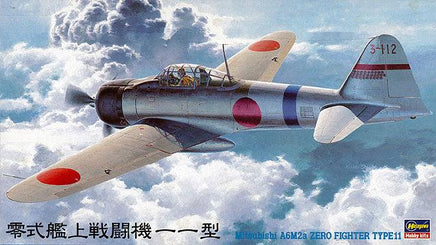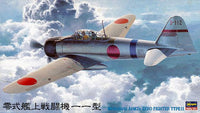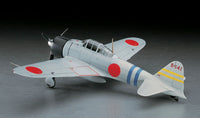The A6M Zero was a fighter plane that served as the Imperial Japanese Navy's main fighter. It had outstanding maneuverability, and its firepower and speed exceeded the standards of carrier-based fighters at the time, even surpassing land-based fighters.
On October 5, 1937, Mitsubishi and Nakajima received the plan requirements for the 12-Shi Carrier Fighter, a main carrier-based fighter following the 96-Shi Carrier Fighter . Mitsubishi began the design with engineer Jiro Horikoshi as the chief designer. Based on the technology he had developed with the 96-Shi Carrier Fighter, Horikoshi went further in the design, reducing weight and resistance. In addition, new attempts were made, such as the adoption of a constant-speed propeller, retractable landing gear, a split structure, a water-drop type sealed windshield, a streamlined drop tank, a Crusey radio return direction finder, the use of ESD (super duralumin), and the installation of a 20mm machine gun in the wing . The first 12-Shi Carrier Fighter (A6M1) was completed with the Zuisei 13 type (takeoff power 780 horsepower).
The first flight took place in April 2014, and the first aircraft achieved good results, recording a speed of over 491 km/h during in-house testing. After that, minor modifications were made, such as changing the propeller from a two-bladed to a three-bladed one and reducing the rigidity of the elevator control system, and the aircraft was handed over to the Navy in September, where inspections began.
Immediately after the start of testing, it was decided that the additional prototypes from the 3rd model onwards, which had their engines replaced with the Sakae 12 type (take-off power 940 horsepower) and their tail arrangement changed, would be called the A6M2, and although there was an accident where the aircraft broke up in mid-air during the review, it was recognized as a good plane and was officially adopted as the A6M2 Zero Type 1 Carrier Fighter Model 1. (In 1942, it was renamed A6M2a, A6M2A Zero Type 11.) Compared to the A6M1, the A6M2 equipped with the Sakae 12 type had an overall length of 270 mm and a weight that was 19 kg heavier, but its maximum speed was improved to 533.4 km/h.
A total of 64 Type 11s were made, and at the request of local troops, they were sent to the Chinese front before they were officially adopted. Since the Type 11s were used as land-based fighters, they were not outfitted as carrier-based fighters. In addition, since the Type 11s used as land-based fighters did not have folding mechanisms on the wingtips, a mechanism was added to the wingtips of the Type 67 and later aircraft to fold them up by 50cm each, making them easier to handle on aircraft carriers .
Furthermore, it was fitted out as a carrier- based fighter with a Crusey radio return direction finder and a landing hook, and was adopted as the A6M2 Zero Type 1 Carrier-based Fighter Model 2 (later renamed A6M2 Zero Type 21, A6M2b).
These Zero fighters were piloted by experienced pilots and demonstrated seemingly invincible strength on various fronts.
-
Crew: 1 person
-
Width: 12.00m
-
Length: 9.060m
-
Height: 3.570m
-
Maximum speed: 533.4km/h (4,300m)
-
Engine: "Sakae" Type 12 (takeoff power 940hp)
- Fixed armament: 2 x 7.7mm machine guns 2 x 20mm machine guns




